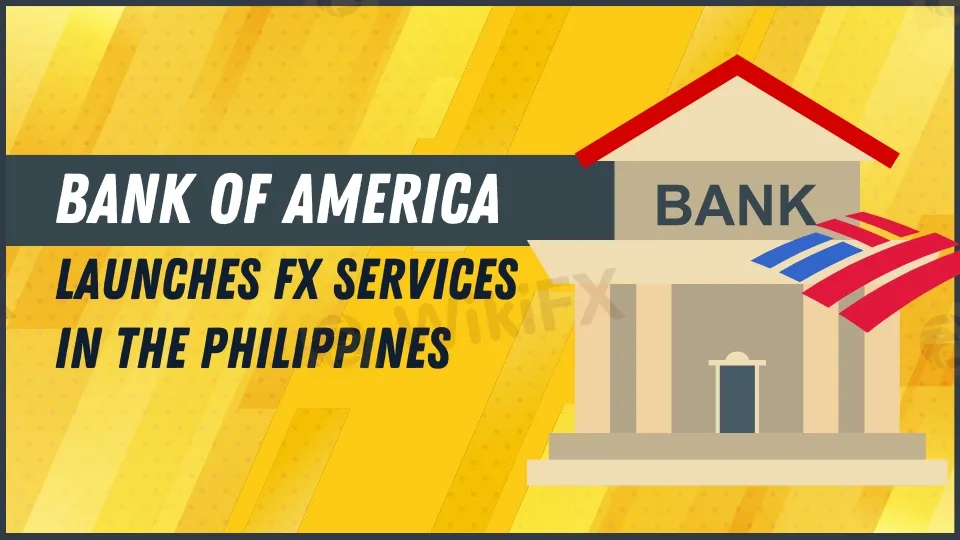简体中文
繁體中文
English
Pусский
日本語
ภาษาไทย
Tiếng Việt
Bahasa Indonesia
Español
हिन्दी
Filippiiniläinen
Français
Deutsch
Português
Türkçe
한국어
العربية
Bank of America Launches FX Services in the Philippines
Abstract:Bank of America begins foreign exchange (FX) services in the Philippines, eyeing a share of the $300 billion onshore currency market. Learn about their growth plans.

Bank of America Eyes $300B Philippine FX Market
Bank of America has formally re-entered the Philippine foreign exchange (FX) market, with ambitious intentions to capture a piece of the Southeast Asian country's estimated $300 billion annual onshore currency sector.
“We do think we will be able to get a pretty good market share of that,” said Shah Jahan Abu Thahir, head of Southeast Asia Global Markets at Bank of America. Thahir, who is based in Singapore, stressed the potential for the country's FX market to expand. “We expect the nation's foreign exchange business to grow substantially over the next few years due to structural tailwinds driving further investments in the Philippines,” according to him.
Investment Fuels Growth
The resurrection of Bank of America's FX operations coincides with an increase in investment from global enterprises, outsourcing firms, and semiconductor manufacturers in the Philippines. The bank's Philippine country head, Vince Valdepeñas, emphasized the increased need for foreign currency services in these businesses.

This is a notable return for the US-based lender, which formerly provided FX and fixed-income services in the Philippines until the early 2000s before focussing on the American market.
Expansion Beyond FX: Fixed-Income Business
Bank of America is also planning to open a fixed-income business in Manila, first targeting international corporations and huge local businesses. This offering will eventually be extended to financial institutions like asset managers and insurers.
Bank of America brings the Philippines into line with its operations in neighboring Southeast Asian countries such as Singapore, Thailand, Indonesia, and Malaysia by offering services in fixed income, currencies, and commodities.
Economic Tailwinds Support Growth
The Philippine economy expanded by 6.3% in the second quarter of this year, boosted by increased consumer spending and the central bank's shift to monetary easing.
We perceive that the Philippine economy is performing nicely. Valdepeñas emphasized that this is a long-term investment as market liquidity increases.
Final Thoughts
The return of Bank of America to the Philippine FX market reflects increased confidence in the country's economic potential. With rising investment prospects and a steady growth rate, the Philippines provides an ideal ground for global financial firms to develop. This expansion not only benefits local sectors but also meshes with the country's larger drive for increased financial integration in Southeast Asia.

Disclaimer:
The views in this article only represent the author's personal views, and do not constitute investment advice on this platform. This platform does not guarantee the accuracy, completeness and timeliness of the information in the article, and will not be liable for any loss caused by the use of or reliance on the information in the article.
Read more

MTrading Users Report Withheld Funds and High Withdrawal Fees
Traders from Kenya and Thailand have had bad experiences with MTrading as they faced withdrawal restrictions, higher deposit fees, and refusal to release funds. Is MTrading safe to trade forex?

How Regulated Brokers' High-Tech Platforms Boost Profits
Discover why regulated brokers’ high-tech platforms boost profits with trust, cutting-edge tools, and risk management. Maximize returns in 2025’s dynamic markets!

MoonPay Opens U.S. Headquarters in NYC Amid Crypto Growth
MoonPay expands its U.S. operations with a new NYC headquarters, driving innovation in crypto payments while navigating evolving regulatory landscapes.

SEC Charges Dallas Trio in $91M Ponzi Scheme Defrauding Investors
The SEC charges Kenneth W. Alexander, Robert D. Welsh, and Caedrynn E. Conner for running a $91M Ponzi scheme, promising false returns and misappropriating funds.
WikiFX Broker
Latest News
Forex Traders Shift Focus: Risk Management Over High Leverage in 2025
Yen's Dramatic Rebound: What Should Investors Do Now?
SEC Charges Dallas Trio in $91M Ponzi Scheme Defrauding Investors
MTrading Users Report Withheld Funds and High Withdrawal Fees
Will Gold Hit $4,000 in 2025? Key Drivers to Watch
How Two Simple Messages Led to a Million-Ringgit Disaster
Valetax $35 No Deposit Bonus
iFourX Scam Alert: Trapped Funds and Silent Support
The Trader’s Dilemma: Dead Cat Bounce vs. Genuine Recovery
He Lost RM558,000 Overnight: Are You Falling for the Same Scam?
Currency Calculator


